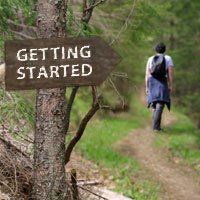60-day returns • free shipping on USA orders $129+


Don’t you love it when you can take just a couple of basic ideas, combine them with a couple of skills, and use them to accomplish a lot?
Take sewing, for example. The basic ideas to keep in mind for general sewing are (1) allow 5/8″ from the edge of the fabric to the seam, and (2) put the right sides of the fabric together.
Combine those ideas with a couple of skills—like (1) learning how to “steer” the fabric as it feeds into the sewing machine, and (2) running the foot pedal—and you can make a pillowcase pretty quickly, or some curtains, or a bedspread.
It feels good to get started with just a few basic ideas and a couple of skills.
And you can get started with the Charlotte Mason Method the same way. Let’s take a look at a couple of basic ideas and a couple of skills that will allow you to accomplish quite a bit.
Basic Principles
The three principles to keep in mind when you’re teaching the Charlotte Mason way are
Keep lessons short.
Charlotte advocated short lessons for younger children: fifteen or twenty minutes at the most. These short lessons are part of training children in the habit of attention. Children can get a lot accomplished in fifteen minutes of complete attention (so can adults). As children grow older, the lesson time should lengthen to thirty or forty-five minutes.
Emphasize good habits.
Charlotte believed that forming good habits in your child makes up one-third of his education. Two very important habits for school time are the habits of attention and best effort. You can encourage these habits from the beginning by emphasizing quality over quantity. Start with short tasks, but require best effort. Read or say things only once. Don’t get caught in the “What?” trap. Set time limits that assume full attention. Start small and gradually work up to longer tasks as these habits are instilled.
Vary the order of subjects.
Along with the short lessons should come a large variety of subjects, alternating the quieter, concentration-intense subjects with the louder, less-concentration-intense subjects and those that allow for physical movement and exercise. Using different parts of the brain and body makes it much easier for your child to pay full attention, because he isn’t overtaxing one part.
Keeping these three basic principles in mind will make your life easier. In sewing, I’ve torn out many a seam because I forgot the basic principle of putting the right sides of the fabric together. When you keep the basic principles in mind, things go much smoother.
Basic Skills
In addition to the three basic principles, let’s get you started quickly with just two basic skills. Once you learn these two methods, you will be able to teach several school subjects in a Charlotte Mason way. You will use these methods to teach history, geography, Bible, science, literature, poetry, and Shakespeare. That’s a lot of subjects you’ll be ready for!
The two methods are
Living Books
Probably the most well known of Charlotte’s methods is her use of living books instead of dry, factual textbooks. Living books are usually written by one person who has a passion for the subject and writes in conversational or narrative style. The books pull you into the subject and involve your emotions, so it’s easy to remember the events and facts. Living books make the subject “come alive.”
So instead of using textbooks for the subjects listed above, look for living books that will make the time period, or the geographical area, or the science concept come alive. Our free CM Bookfinder will give you lots of suggestions for living books, and our free SCM Curriculum Guide lists our favorites.
And when you’re ready to fine-tune this skill, read this article on “Choosing Books Like a Connoisseur” or get a copy of our Books and Things Seminar on DVD.
Narration
When you ask a child to narrate, you’re asking him to tell back in his own words what he just saw, heard, or read. Because the child must think through the information and determine how to present it, mixed with his own opinion and impressions, this method of evaluation requires a much higher thinking level than mere fill-in-the-blank or answer-the-posed-question-with-a-fact methods.
So read a portion of your living book and then ask your child to tell you everything he can remember. (Keep in mind the habit of attention. This method will put it to good use!)
When requesting a child to narrate, word the question in an open, essay-type form, such as “Tell all you know about _____” or “Describe _____.” The narration can be oral or written or drawn—whatever. Here are some more narration ideas.
When you’re ready to hone this skill, read the article “Using Living Books Effectively”. Also, the Books and Things Seminar on DVD mentioned above spends a lot of time helping you with narration.
Next week we’ll talk about some hands-on learning with the Charlotte Mason Method.
CM Method Workshops in Chattanooga, Tennessee
This Friday and Saturday, July 23 and 24, Sonya will be presenting several Charlotte Mason workshops at the CSTHEA Curriculum Fair near Chattanooga, Tennessee. If you’re in the area, stop by. You will be able to learn a lot from these workshops on
- Charlotte Mason and Her Methods
- Laying Down the Rails: The Power of Good Habits in Your Homeschool
- The Early Years: Homeschooling Your Preschooler
- Spelling and Handwriting Wisdom
We will have all of our resources at our booth and would love to see you there!
